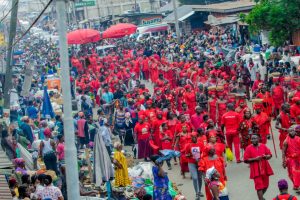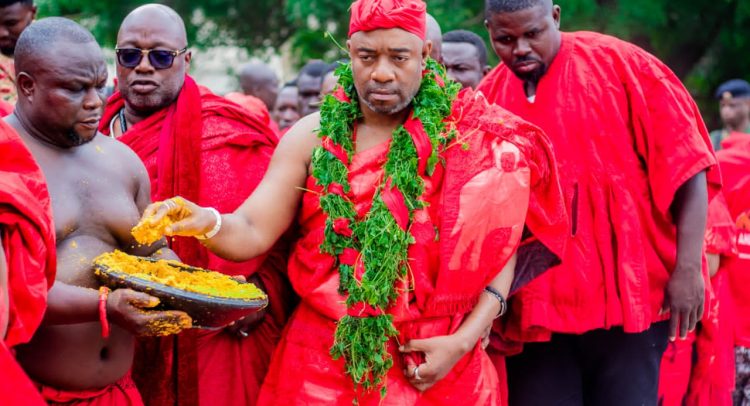King Tackie Teiko Tsuru II
The Ga Mantse, Nii Tackie Teiko Tsuru II in the dawn light of Saturday August 17, 2024 led other King makers to parade through the Ga state to honour the spirits of Ga kings who have departed the world.
The occasion was the annual Ma’amɛn celebration, held every year after the Homowo festival to recognise the Ga culture and tradition.
The procession began at Ga Kinka, with
Nii Tackie Teiko Tsuru II, dressed in traditional attire which depicts the rich Ga heritage Accompanied by elders dignitaries began the procession at G Kinka which began the procession at Ga Kinka.

They made the six-mile trek to Mantseman, a sacred enclave known as the resting place of some of the most esteemed Ga royals.
Mantseman, located within the historic area of ‘Tɛsaanɔ’, does not only serve as a burial ground but also serves as a spiritual haven where the legacy of kings like Nii Tackie Tawiah II lives on.
For the Ga people, Mantseman is a place where the past is always present, where the spirits of their ancestors continue to watch over them.
As the procession reached the royal mausoleum at Mantseman, a profound silence fell over the gathering as Nii Tackie Teiko Tsuru II carried out the sacred duty of feeding the ancestors.
With great care and respect, he sprinkled a traditional meal of palm soup and kpokpoi on the tombs of the departed kings to ensure they were well-nourished even after life symbolising the Ga belief in the continuity of life and the enduring influence of their ancestors.
The solemnity of the moment was heightened by the rhythmic beats of Obonu drums and the low, resonant notes of traditional horns. As the Ga Mantse poured libation, offering gin and prayers to the spirits, the air was thick with a sense of connection to the spiritual world.
The pilgrimage did not only end at Mantseman but the procession moved southward to Akpade bu, where another revered Ga king, Nii Tackie Tawiah I, whose reign in the late 19th century did not only shape the future of Accra but also remembered for his wisdom and leadership was buried. shaped was buried.
At his tomb, King Tackie Teiko Tsuru II performed the same rituals of feeding and asking for the continued protection and guidance of the ancestors.
The journey continued through the heart of Accra, passing historic landmarks such as the Central Business District, the General Post Office, and the statue of King Tackie Tawiah I at Makola Market.
At each stop, the Ga Mantse paused to honour the legacy of his predecessors, offering kpokpoi and libation with the firing of muskets and the pulsating rhythm of drums.
The final destination was the Ga Mantse Stool House, where the leaders of the Ga State performed the ‘Jwalamo’ purification rite, marking the end of the ‘Ma’amɛn’ celebration serving as a spiritual cleansing for the participants, reinforcing their connection to their ancestors and to each other.
The ‘Ma’amɛn’ celebration is also testament to the enduring strength of Ga traditions in a modern world with a pilgrimage that afforded Nii Tackie Teiko Tsuru II not only an opprtunity to honour the memory of past kings but also reaffirmed the cultural identity of the Ga people.
In a time where much is changing, the Ma’amɛn ceremony stands as a proud reminder of the importance of heritage, faith, and the deep respect that the Ga people have for those who came before them.
King Tackie Teiko Tsuru II’s journey to Mantseman is a story of honor, reverence, and cultural pride—a journey that links the living with the spirits of their ancestors, ensuring that the legacy of the Ga people continues to thrive.


